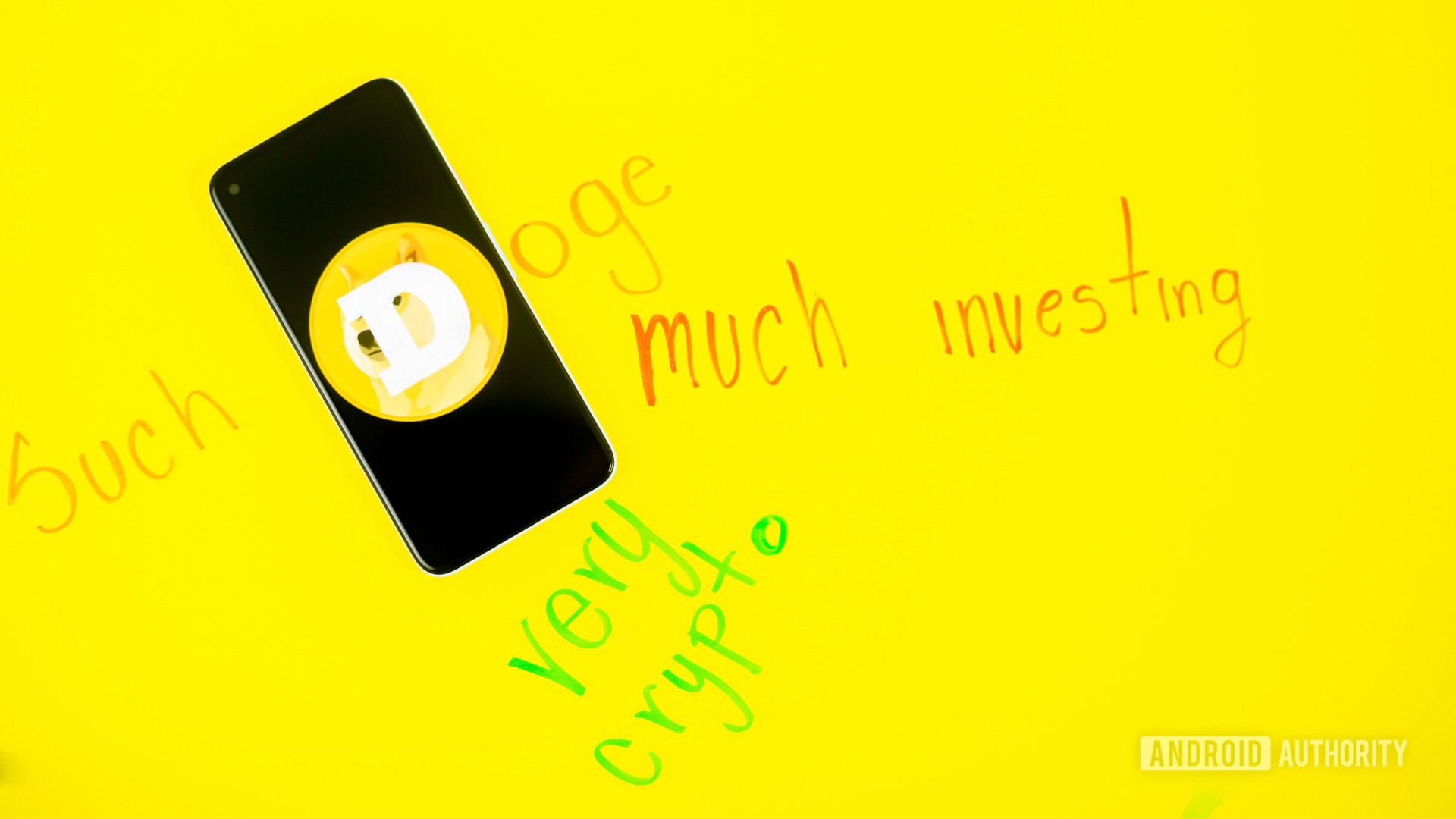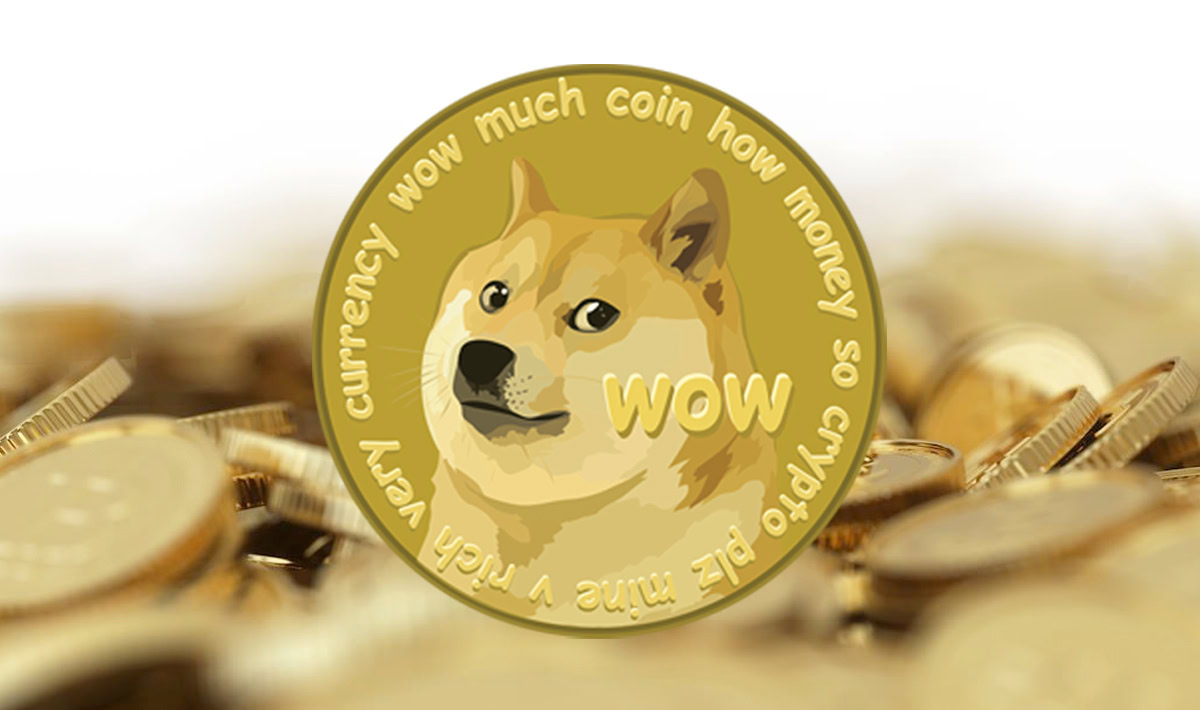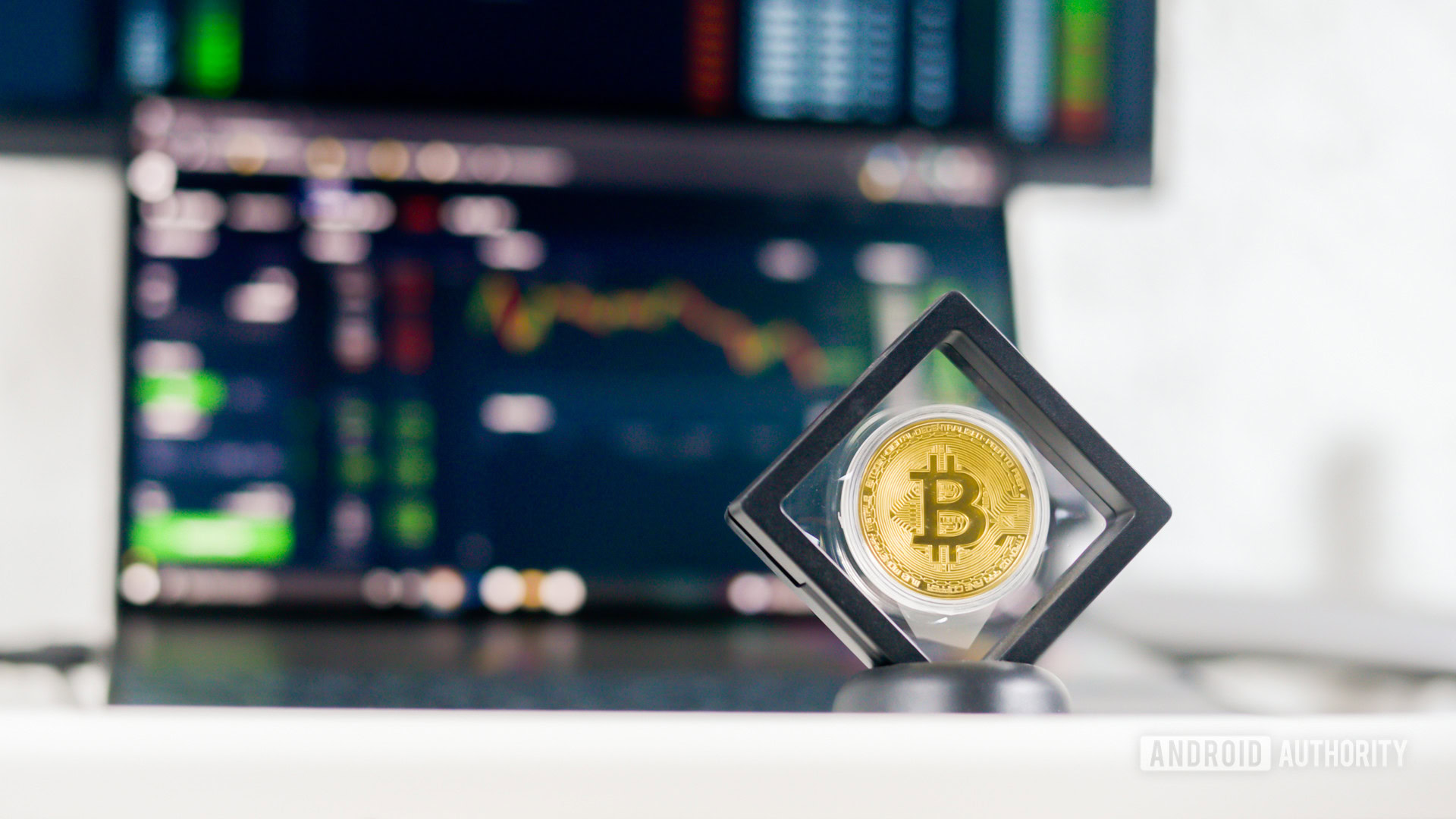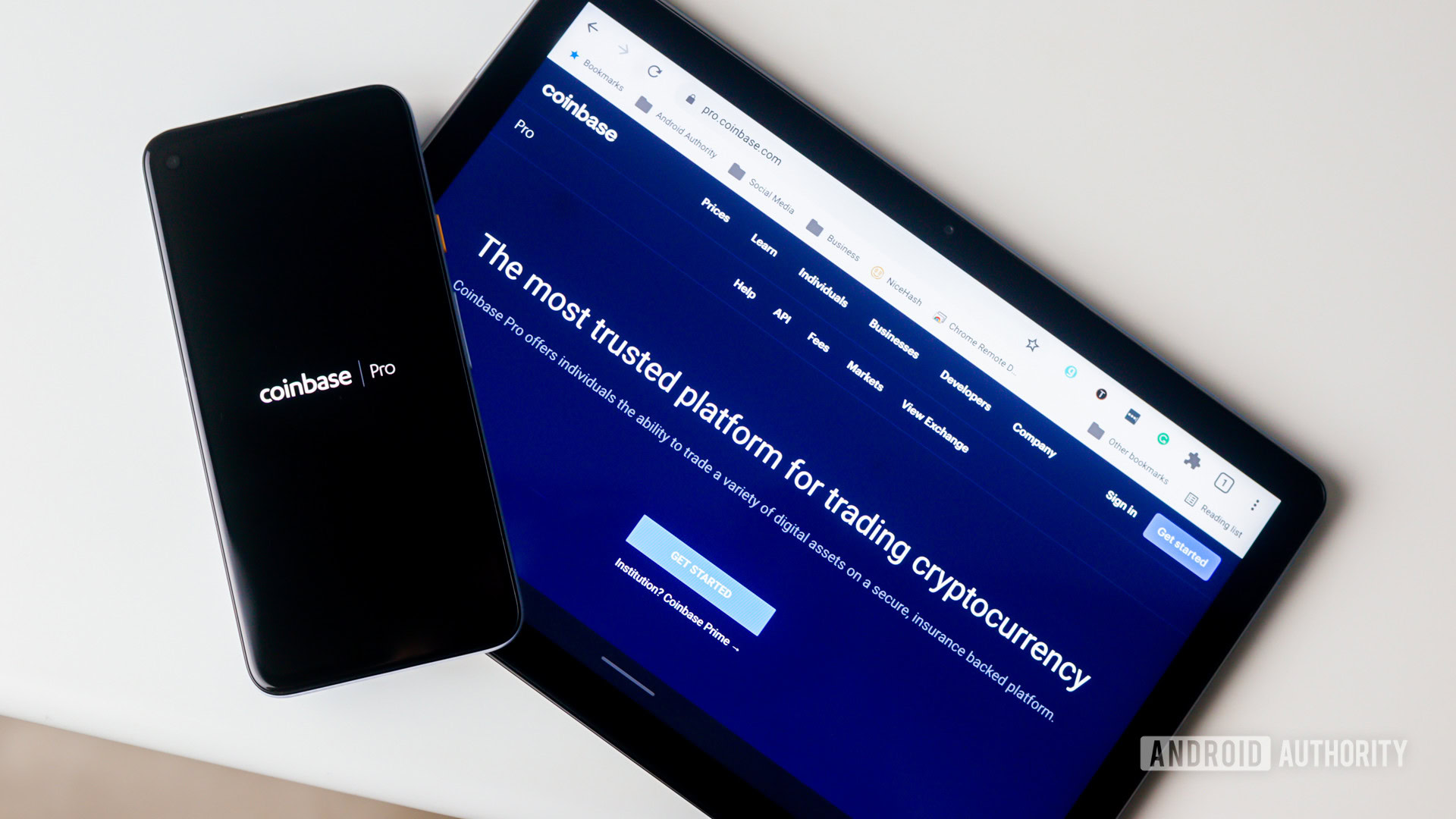Affiliate links on Android Authority may earn us a commission. Learn more.
Dogecoin: Is it the currency of the internet or just a memecoin?

Out of seemingly nowhere, Dogecoin has skyrocketed in popularity across the world. Once a small and unassuming cryptocurrency token, it is now worth billions of dollars.
Created in 2013 as a light-hearted jab at cryptocurrencies such as Bitcoin, Dogecoin never claimed to be a serious financial asset. Even its name and logo are derived from the then-prevalent Doge meme involving a confused-looking Shiba Inu dog. Despite that, at its peak in the first half of 2021, Dogecoin’s price briefly topped $0.74 with a valuation of nearly $100 billion.
It’s easy to get caught up in the hype of Dogecoin’s surging popularity and record-breaking price gains. Look under this veil, however, and you’ll find several lingering uncertainties and questions that will make you wonder how it became one of the world’s most valuable cryptocurrencies.
See also: The best cryptocurrency apps for Android
To that end, let’s explore what Dogecoin is and where its popularity comes from.
Understanding the basics
Cryptocurrencies are a relatively new technology. As with any new paradigm, you may come across certain terminology unique to the crypto market. Before we dive into the inner workings of Dogecoin, here are a few terms you should know:
Blockchain:
Simply put, a blockchain is a ledger of transactions that are distributed across hundreds or thousands of computers around the world. This allows them to function even in the absence of central banks and other intermediaries. Cryptocurrency blockchains are usually accompanied by a mechanism to authenticate new transactions.
ERC-20 Token:
This complicated-sounding phrase refers to any token that is built on top of the Ethereum blockchain. ERC-20 refers to Ethereum’s specification for third-party developer tokens. Added in 2015, the ERC-20 spec makes it significantly easier for developers to create tokens as the underlying Ethereum blockchain carries out most heavy lifting.
Fork:
This term is actually not unique to the cryptocurrency industry. Instead, it has its origins in the open-source software ecosystem. A fork essentially refers to the development of a particular project splitting off into two branches. This is usually done either to create new spin-off projects like Dogecoin or resolve disputes within the community, as in the case of Bitcoin Cash.
Some cryptocurrencies, like Ethereum, also use forks to implement network upgrades. The old branch is abandoned in those cases.
What is Dogecoin?

Put simply, Dogecoin is a digital currency that can be used either as an investment instrument or electronic cash. More specifically, it is a modified version of the Litecoin cryptocurrency, which is a fork or spin-off of Bitcoin.
All of this means that Dogecoin is practically no different from the vast majority of cryptocurrencies from the same era. This is both a good and bad thing, however.
Thanks to Dogecoin’s origins, you can pretty much guarantee that it is at least as usable as Litecoin or Bitcoin is. All three are based on the same underlying technology and share the foundational principle of decentralization. No central authority can shut them down or manipulate their networks to a significant degree, so the fate of these cryptocurrencies lies entirely in the hands of the community.
On the other hand, though, these similarities mean that there is no practical differentiator between Dogecoin and Litecoin. If you need to transfer money across borders, for example, you could just as easily use Litecoin or Bitcoin. Granted, using either of these may involve paying a higher transaction fee — but you also get the benefit of a more widely-used network and a recognized brand name.
That’s not to say that Dogecoin is indistinguishable from the competition, though. The biggest difference between Dogecoin and Bitcoin is that the former has no supply cap. While there will only ever be 21 million Bitcoin, Dogecoin already has a circulating supply of 130 billion. That number is also expected to grow since the cryptocurrency’s code is designed to mint 5 billion tokens every year.
What does this mean? Well, token economics can have a rather outsized impact on the usability and price of any cryptocurrency. Just like with the US dollar, a continuous increase in supply can cause inflation. In simple words, this means that existing dollars (or tokens, in the case of Dogecoin) drop in valuation.
The ever-growing supply is a big reason why Dogecoin’s market capitalization stands at a whopping $30 billion, even though each token is only worth around $0.24. On the other hand, Bitcoin’s $650 billion market cap was achieved with a staggering unit price of around $35,000.
So why did Dogecoin beat Bitcoin in terms of price gains throughout the first half of 2021, despite its lack of originality and inflationary nature?
The Dogecoin Hype Cycle

Hype has been a mainstay of the Dogecoin community ever since its inception in 2013. Its price nearly quadrupled within 72 hours of its original release — jumping from $0.00026 to $0.00095. Daily trading volumes hovered around the billion-dollar mark. A few days later, it lost 80% of its value, highlighting just how volatile the market was.
However, at the time, nobody expected Dogecoin to become a replacement for Bitcoin or any other cryptocurrency. It was always meant to be a satirical take on the market, with the goal of perhaps reaching a wider demographic than Bitcoin could at the time. It succeeded in this regard.
Dogecoin continued to gain momentum in the years that followed and carved out a niche for itself. Since 2014, the cryptocurrency’s loyalists have collectively sponsored various fundraising events and organized a handful of philanthropic acts.
The first major act involved the community’s $50,000 donation to send the Jamaican Bobsled Team to the 2014 Sochi Winter Olympics. A few months later, in March 2014, the Doge4Water fundraiser successfully raised nearly $32,000 worth of Dogecoin to build a well in drought-struck Kenya.
Around the same time, the Dogecoin community also collectively pooled 67.8 million Dogecoins to put the cryptocurrency’s logo and name on a NASCAR race car. The sponsored paint scheme ended up being a major win for the Dogecoin community, which suddenly found itself in the favorable spotlight of mainstream media.
Dozens of smaller-scale charity events were also held in the Dogecoin subreddit — such as the one involving a Shiba Inu animal rescue in Colorado. Other than that, Dogecoin-based tips were commonplace on platforms such as Twitter and Reddit. All of this encouraged the price upwards over time.
By 2018, the cryptocurrency had reached an all-time high of $0.017. However, by this time, the original co-founders of Dogecoin had all but abandoned involvement with the project. Billy Markus, the software engineer that designed Dogecoin’s protocol, famously sold all of his Dogecoin holdings in 2015.
Markus later said, “I gave away and/or sold all the crypto I had back in 2015, after being laid off and scared about my dwindling savings at the time, for about enough in total to buy a used Honda Civic.”
The rise of Dogecoin in 2021 and Elon Musk
While Dogecoin has always been a widely-known token in the cryptocurrency community, it arguably didn’t truly reach mainstream popularity until 2020.
Elon Musk, of Tesla fame, took a sudden interest in the meme token around that time. In July 2020, Musk claimed that the Dogecoin standard would replace the world’s financial system. This caused the token’s price to rise 14% overnight.
It’s inevitable pic.twitter.com/eBKnQm6QyF— Elon Musk (@elonmusk) July 18, 2020
It didn’t take long before Musk began tweeting about Dogecoin almost daily. The barrage of tweets reached critical mass between December 2020 and May 2021. For a while, it seemed as if every single Dogecoin-related tweet from Musk would send the price soaring — almost like clockwork.
While Musk’s overwhelming interest in Dogecoin did spark an unprecedented rally, it was also helped by the attempted GameStop short squeeze in January 2021. Social media-fueled investors piled into the cryptocurrency, believing that Dogecoin was the crypto-equivalent of heavily shorted meme stocks such as GameStop and AMC.
What most inexperienced investors failed to realize, however, is that Gamestop’s situation was unique. Unlike the aforementioned stocks, Dogecoin had nearly zero short-selling pressure. Once this came to light, platforms like Reddit began steering the discussion towards speculations of how Dogecoin could someday become the “currency of the internet.”
Ultimately, Dogecoin reached an all-time high of $0.74 on May 8, 2021 — the very same day Elon Musk evangelized the token during his guest appearance on Saturday Night Live. However, Dogecoin, along with most other cryptocurrencies, exhibited a downward trend over the following weeks.
With an estimated peak return of over 14,000%, Dogecoin’s performance surpassed that of nearly every single notable cryptocurrency in the first two quarters of 2021.
Dogecoin’s many knock-offs
In an attempt to mimic Dogecoin’s sudden rise in popularity, a slew of Dogecoin-inspired meme cryptocurrencies also hit the market in early 2021. The Shiba Inu token (ticker SHIB) is undeniably the most well-known of these tokens, having branded itself as a ‘Dogecoin killer.’ However, it presented no real merit to these claims — especially given that it does nothing that Dogecoin doesn’t already.
Furthermore, Shiba Inu is an ERC-20 token, which means that it is built on the Ethereum blockchain. Dogecoin, in comparison, uses its own blockchain and network for transaction validation. This is an important distinction because the Ethereum network can only process a few transactions per second.
When SHIB peaked in popularity, it congested the entire Ethereum network. This caused transaction fees to spike exponentially and settlement times to slow to a crawl. Consequently, SHIB couldn’t compete with Dogecoin at the most basic level, let alone kill it. That is unlikely to change either — at least until Ethereum completes its long-awaited network upgrade.
Despite these deficiencies, SHIB’s valuation peaked at a staggering $13 billion around the same time Dogecoin neared the $100 billion mark. Part of this was because SHIB’s total token supply was set to one quadrillion — an astonishingly high number, even for the cryptocurrency market. For reference, Bitcoin’s total supply is capped at 21 million, while there are only around 130 billion DOGE tokens in circulation.
Consequently, investors on popular social media platforms were misled into believing that SHIB was undervalued at $0.0000015 per token. This sentiment provoked a cascade of investments from oblivious or new traders, pushing the token to $0.00003431 in under a week. Naturally, however, this rally was not sustained because SHIB and market forces brought the token’s price to lower levels.
SHIB was not the only meme token that gripped retail investors in 2021. A few other popular tokens were Dogelon Mars, Akita Inu, and Baby Doge Coin.
However, almost every single meme cryptocurrency other than Dogecoin has only survived a few hype-induced price rises so far. Naturally, this has prompted many to question the speculative nature of these tokens. Given that the cryptocurrency market is unregulated, not much can be done even if these tokens are indeed pump and dump scams.
Either way, the lesson here is to stay wary of tokens built on hype — especially if you’re a new investor.
Dogecoin alternatives worth considering

Even with Dogecoin’s strong community backing, you may be hesitant at the prospect of buying a meme cryptocurrency. To that end, here are a few alternative cryptocurrencies that you should consider:
Bitcoin: As the world’s largest cryptocurrency, there’s perhaps no other cryptocurrency with a larger brand name and recognition than Bitcoin. While it is still absolutely a volatile asset, its wide acceptance and age may appeal to those looking for a more conventional cryptocurrency investment asset.
See also: Bitcoin — the controversial digital currency worth billions — explained
Stablecoins (USDT/DAI): If you’re considering a digital currency purely for cross-border transactions, stablecoins are a good option. They negate the risk of volatility prevalent with Dogecoin and other digital currencies. Since stablecoins are designed to trade at a fixed value, they’re not meant to be treated as a speculative investment.
Should you buy Dogecoin?

Copycats aside, Dogecoin has managed to stay on a consistent upward trend for nearly a decade at this point. Given this historical data, then, should you allocate a portion of your investment portfolio to the largest meme currency on the market?
The answer is complicated and depends heavily on your appetite for risk. As mentioned above, Dogecoin has little utility when compared to more mainstream cryptocurrencies such as Bitcoin and Ethereum. To that end, the only thing keeping Dogecoin relevant is the fact that it has a strong, vibrant, and outspoken community.
Over the years, the Dogecoin community has also contributed to social good. If these factors appeal to you, owning a few tokens wouldn’t be a bad idea.
However, as an investment, there is no telling where Dogecoin will be in a few years or even a few months from today. Furthermore, its daily volatility is much higher — so it’s not quite easy to profit from swing trades either.
Adoption remains the only selling point for Dogecoin. According to Cryptwerk, over a thousand merchants support Dogecoin. You could, for instance, use DOGE to buy gift cards on Bitrefill or spend tokens at a local business. However, there’s also a significant degree of overlap between merchants that accept both Dogecoin and other cryptocurrencies.
Nevertheless, if you decide to buy some Dogecoin, the first order of business would be to sign up for an account at a cryptocurrency exchange such as Coinbase.
See also: The best crypto wallets for Android
Frequently asked questions
Q: How do I safely store my Dogecoin?
A: If you’ve already purchased some Dogecoin, your next priority should be to secure them in a personal wallet. This is especially important if you plan to hold them for a longer duration since exchanges are larger targets for hackers than any individual.
The most secure option would be a hardware wallet like the Ledger Nano S or Trezor Model T. If your holdings are relatively small, however, you can also get by with a software wallet on your smartphone or computer. Check out the official Dogecoin website for platform-specific recommendations.
Q: How is the Dogecoin network secured?
A: Since Dogecoin is based on the same technology as Bitcoin and Litecoin, it too uses the Proof of Work consensus mechanism. This means that new transactions are validated through a competitive process known as mining. Individuals from around the world dedicate their computing resources to the process and receive a reward relative to their effort.
Dogecoin’s Proof of Work differs from Bitcoin or Litecoin to some degree, but the fundamentals are still pretty much the same. To learn more about mining, check out our dedicated article on the subject.
Q: Can anyone mine Dogecoin?
A: There are absolutely no restrictions on who can mine Dogecoin. However, growing competition has rendered consumer-grade hardware obsolete for mining. These days, miners use specialized hardware, called ASICs, to mine most cryptocurrencies — including Dogecoin.
The profitability of mining depends on several factors, including Dogecoin’s current price, how much you paid for the equipment, and electricity.
Q: How long does it take for a Dogecoin transaction to complete?
A: Dogecoin has a block time of approximately one minute. This is shorter than Bitcoin’s 10-minute average, which means transactions should be faster on the Dogecoin network. Furthermore, Dogecoin rarely ever undergoes high user activity periods, while most of its competitors are far more likely to face congestion due to their relative popularity.
Q: Are Dogecoin developers working on scaling the cryptocurrency?
A: Scalability is a contentious topic in the cryptocurrency industry, so it is naturally a key point of focus for the Dogecoin community. Furthermore, many detractors of Proof of Work-based cryptocurrencies point to their overwhelming use of electricity to process a handful of transactions per day.
To that end, Dogecoin’s developers have acknowledged the need to improve the network’s transaction throughput. Until 2021, development on the Dogecoin blockchain had slowed to a crawl. With the increased attention, however, the community sprung back into action. Two proposals designed to modernize the network and lower fees were subsequently accepted by Q3 2021.